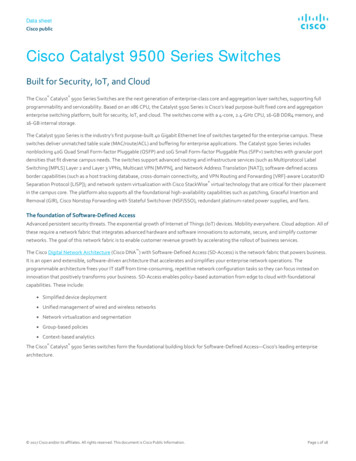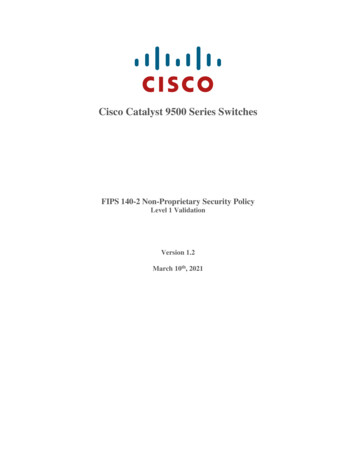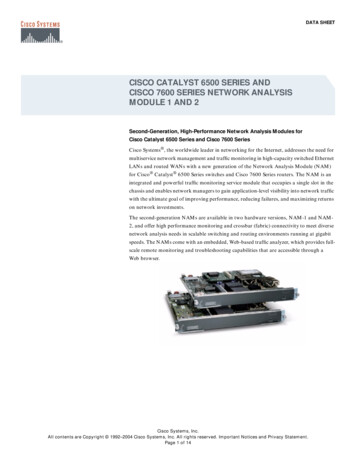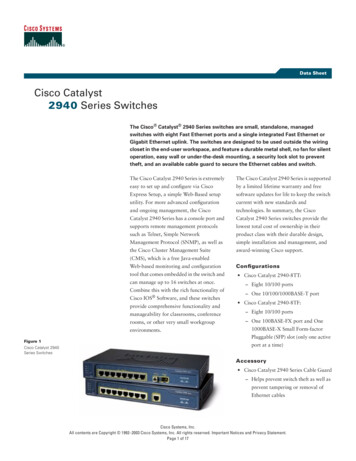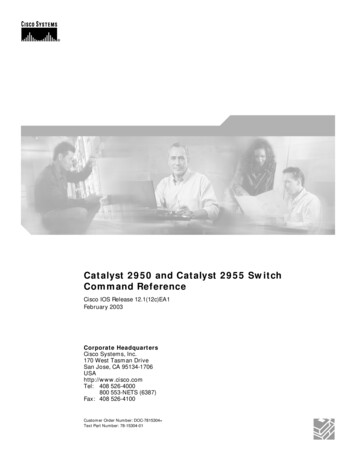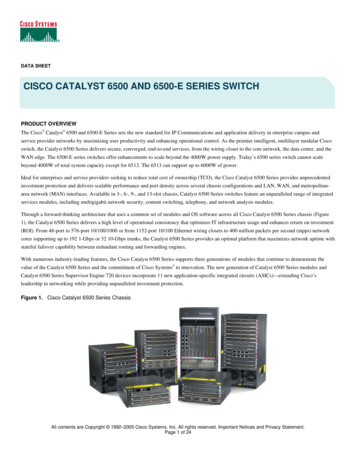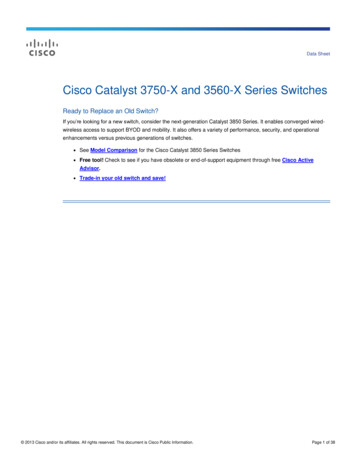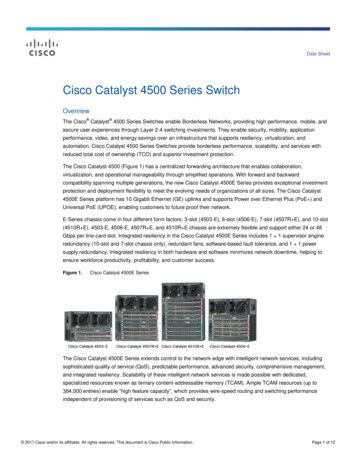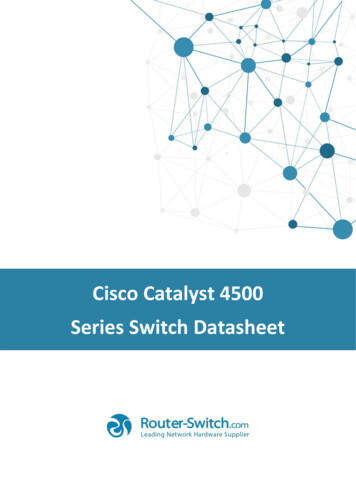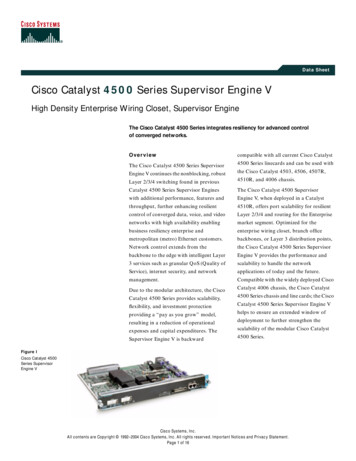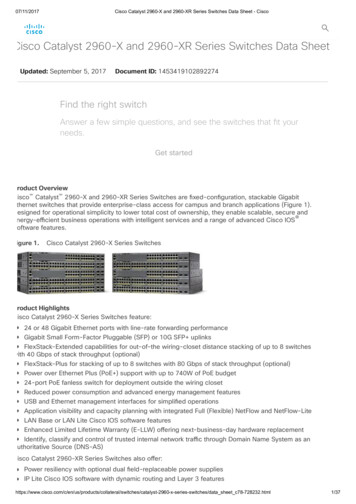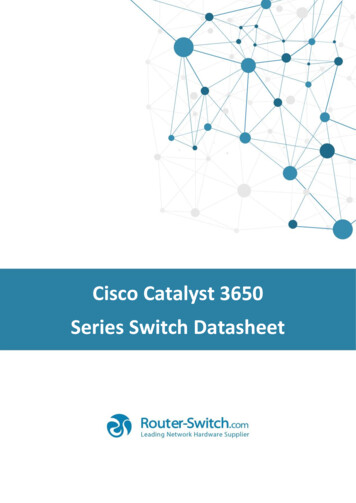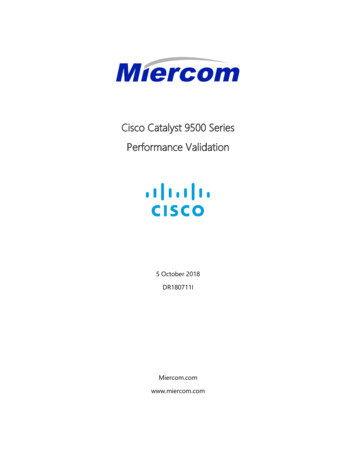
Transcription
Cisco Catalyst 9500 SeriesPerformance Validation5 October 2018DR180711IMiercom.comwww.miercom.com
Contents1.0 Executive Summary . 32.0 Product Tested . 43.0 How We Did It . 53.1 Ixia Test System . 63.2 Equipment Used . 64.0 RFC 2544 Performance. 84.1 Cisco Catalyst 9500-32C . 94.2 Cisco Catalyst 9500-32QC . 124.3 Cisco Catalyst 9500-48Y4C . 155.0 RFC 2889 Performance. 185.2 Cisco Catalyst 9500-32QC . 195.3 Cisco Catalyst 9500-48Y4C . 226.0 RFC 3918 Performance. 256.1 Cisco Catalyst 9500-32C . 266.2 Cisco Catalyst 9500-32QC . 286.3 Cisco Catalyst 9500-48Y4C . 30About Miercom . 32Customer Use and Evaluation . 32Use of This Report . 32Cisco Catalyst 9500 SeriesCopyright 2018 Miercom2DR180711I5 October 2018
1.0 Executive SummaryHigh-density switches manage communications heavily reliant on aggregating and routingtechnology to ensure intelligent forwarding. The port density is ever increasing to meetenterprise campus needs, and performance in realistic deployment scenarios should beevaluated to validate data sheet specifications.Cisco Systems, Inc. engaged Miercom to validate aggregate Gigabit Ethernet (GE) throughputcapacity and latency of its Catalyst 9500 High Performance Series Switches – C9500-32C(100GE), C9500-32QC (40GE) and C9500-48Y4C (25GE). Using an Ixia IxNetwork test system, wesimulated high-density traffic of different frame sizes, ranging from 192 to 9216 bytes. RFC 2544and 2889 tests were conducted over Layer 2 and Layer 3, RFC 3918 was performed over Layer 3.The percentage of line rate and latency were recorded.Key Findings for the Cisco Catalyst 9500 High Performance series Offers up to 2 Bpps forwarding performance and 3.2 Tbps total switching throughput Each Catalyst 9500 High Performance Series Switch delivered full line-rate throughputon every port for all packet sizes of 192 bytes or larger, with zero packet loss, based onhigh-density RFC 2544 unicast and RFC 3918 multicast throughput testing. Latency for unicast and mesh throughput testing was as low as 3.02µs and 3.04 µsfor multicast performance.Miercom has independently observed the performance of theCisco Catalyst 9500 High Performance Series 100/40/25GESwitches and awards the Miercom Performance sperformance in accordance with RFC 2544 and 3918.provenRobert SmithersCEOMiercomCisco Catalyst 9500 SeriesCopyright 2018 Miercom3DR180711I5 October 2018
2.0 Product TestedThe Cisco Catalyst 9500 High Performance Series Switches are the industry’s first purpose-builtfixed 1-RU core and distribution layer switches based on Cisco UADP ASIC architecture, runningon Cisco IOS XE operating system. These switches deliver exceptional table scales and bufferingcapabilities while also supporting all the foundational high-availability capabilities, includingdual redundant power supplies and variable-speed highly efficient redundant fans. Theseswitches operate at line rate and offer configurable system resources to optimize support forspecific features. Below are the product highlights. 3.2-Tbps switching capacity with up to 2 Bpps of forwarding performance212,000 routing entries (IPv4/IPv6)Quadcore 2.4-GHz x86 CPU,16-GB DDR4 memory and 16-GB internal storageUnmatched MAC/route/ACL table scalability and buffering100/40GE nonblocking Quad Small Form-Factor Pluggable (QSFP , QSFP28)25/10/1GE Small Form-Factor Pluggable Plus (SFP/SFP /SFP28)Advanced routing and infrastructure services – Multiprotocol Label Switching (MPLS), Layer 2 &Layer 3 Virtual Private Network (VPN), Multicast VPN and Network Address Translation (NAT) Cisco Unified Access Data Plane (UADP) Application-Specific Integrated Circuit (ASIC)Cisco Digital Network Architecture (DNA) with Cisco Software-Defined Access (SDA) capabilities,such as host-tracking database, cross-domain connectivity and VPN Routing and Forwarding(VRF) aware Locator/ID Separation Protocol (LISP) to extend and simplify network fabricoperations by automating IT tasks and security for minimized downtime and maintenance Network system virtualization with Cisco StackWise virtual technology for campus coreHigh-availability capabilities such as patching, Graceful Insertion and Removal (GIR), CiscoNonstop Forwarding with Stateful Switchover (NSF/SSO), redundant platinum-rated powersupplies, and fans Cisco IOS XE Software – modern operating system for model-driven programmability, on-boxPython scripting, streaming telemetry, container-based application hosting, patching and built-indefense against runtime attacks Cisco Plug and Play (PnP) enabled for simple, secure, unified and integrated method of branch orcampus rollouts and updates for existing networks Encrypted Traffic Analytics (ETA) to identify and remediate threats or network anomalies withinencrypted communicationsCatalyst 9500-32C32 x 100GECatalyst 9500-32QC32 x 40GECatalyst 9500-48Y4C48 x 25 GE 4 x 100G UplinkCisco Catalyst 9500 SeriesCopyright 2018 Miercom4DR180711I5 October 2018
3.0 How We Did ItUsing hands-on network testing tools, business environments are simulated and challenged withreal-world traffic scenarios to provide an accurate assessment of product performance. Testingof the Cisco Catalyst 9500-32C/32QC/48Y4C switches employed multiple, centrally controlledIxia XGS12 multi-slot chassis. Aggregated test systems yield bidirectional 100/40/25GE testports, one for each corresponding port on the Device Under Test (DUT).The following steps were taken prior to testing of each DUT:1. Array of Ixia XGS12 test systems were connected to the DUT2. One Ixia system test port was connected to each 100/40/25GE port on the switch,depending on the model used (C9500-32C used 100GE; C9500-32QC used 40GE;C9500-48Y4C used 25GE)3. Connectivity was confirmed on each port to avoid re-cabling for duration of testingA battery of tests was applied to each switch to examine different aspects of the DUT. Theprocedures for testing Layer 2 and Layer 3 switches and routers have been standardized. Four ofthe standards used in this testing, incorporated in the Ixia test system, are publicly available asInternet Requests for Comments, or RFCs. The ones applicable to this assessment include RFCs2544, 2889 and 3918 for throughput and latency.Traffic consisted of the following packet sizes: 192, 256, 512, 1024, 1518 and 9216 bytesIMIX – L2/IPv4: 64, 512 and 1518 bytes; IPv6: 86, 512 and 1518 bytesCisco Catalyst 9500 SeriesCopyright 2018 Miercom5DR180711I5 October 2018
3.1 Ixia Test SystemThe Ixia XGS12 is a versatile multi-slot test system whichaccepts various port modules and offers a special softwareload for running IEEE-specified performance tests. Suchsoftware includes IxNetwork, IxLoad and BreakingPointtest applications and automation APIs for massive-scaleLayer 2-7 testing on high-density switches, such as those indata center deployments.In this testing, multiple Ixia XGS12 chassis were driven bythe IxNetwork application, which features an extensive libraryof test methodologies and supported scenarios. This trafficgenerator delivered test network traffic through each DUT.Source: Ixia3.2 Equipment UsedHardwareSoftware VersionDUTCatalyst 9500 High Performance SKU’sIOS XE 16.8.1Test EquipmentIxia XGS12 High Performance ChassisIxOS 8.40.1400.5 EAIxNetwork 8.40.1124.8 EACablingQSFP-100G-AOC3M/5MQSFP-100G-SR4-S with MPO Ribbon CableQSFP-H40G-AOC3M/5MQSFP-4SFP25G-CU5MCisco Catalyst 9500 SeriesCopyright 2018 Miercom6DR180711I5 October 2018
Test BedDUTs:Test System:Ixia XGS12 chassiswith IxNetwork32 test ports of100GECatalyst 9500-32C32 x 100GECatalyst 9500-32QC32 x 40GE32 test ports of40GE48 test ports of25GE 4 testports of 100GECatalyst 9500-48Y4C48 x 25 GE 4 x 100G UplinkSource: MiercomActual Test Site:Shown left is one of the switches under test,connected via QSFP cabling to the Ixia test system.Source: MiercomCisco Catalyst 9500 SeriesCopyright 2018 Miercom7DR180711I5 October 2018
4.0 RFC 2544 PerformanceThis standard was issued in 1999 to describe how to conduct basic benchmark tests forthroughput and latency measurements. Bidirectional Layer 2 and Layer 3 traffic was applied onport pairs on the DUT, so that traffic was processed across the switch fabric.This test determines the maximum rate at which the DUT receives and forwards traffic across allports without frame loss. Frames are sent at a specified rate which increases until frame lossoccurs. Once the maximum traffic rate, right before a single packet is lost, is established for aframe size, the minimum, average and maximum latency (in microseconds, µs) was calculated asthe difference in timestamps from packets sent and received by the Ixia system.The Ixia system was configured with one-to-one traffic mapping and to forward and receivetraffic to and from each directly connected port on the switch. Initially, frames were sent at therated throughput of the port. When the DUT accepts and successfully processes all traffic at thetheoretical rate based on the speed of the port, the switch is said to have performed at “wirespeed” or “full line rate” for the packet size. If the maximum was not achieved, it was recorded asa percentage of the line rate throughput. The DUT was configured for Layer 2 and Layer 3switching and endured a stress test of meshed traffic load distribution that traversed both thelocal line card and other line cards to force traffic across all the fabric modules, in accordancewith RFC 2544. For latency measurements, tested was conducted using store and forward mode.Throughput and latency was measured for the following models: Section 4.1 – Cisco Catalyst 9500-32C: 100GESection 4.2 – Cisco Catalyst 9500-32QC: 40GESection 4.3 – Cisco Catalyst 9500-48Y4C: 25GECisco Catalyst 9500 SeriesCopyright 2018 Miercom8DR180711I5 October 2018
4.1 Cisco Catalyst 9500-32CLayer 2: 100GE Throughput and LatencyCisco Catalyst 9500-32CRFC 2544 100GE Layer 2 ThroughputTHROUGHPUT(% LINE 16IMIX6040200FRAME SIZE (BYTES)Source: MiercomThe Cisco Catalyst 9500-32C exhibited full line-rate forwarding performance for allframe sizes with all 100GE ports loaded. Test results shown are for the 100GE port-pair testing configuration. The switch endured a maximum sustainable loadwithout loss for Layer 2 unicast traffic for frames sizes ranging from 192 to 9216bytes and an IMIX weighted mixture of frame sizes. Testing was conducted inLATENCY(MICROSECONDS)accordance with RFC 2544.4.003.803.603.403.203.00Cisco Catalyst 9500-32CRFC 2544 100GE Layer 2 Latency192256FRAME SIZE (BYTES)512102415189216IMIXMin Latency3.283.283.293.253.293.713.28Avg Latency3.423.373.353.373.383.773.47Max Latency3.493.473.453.443.513.933.64Source: MiercomThe Cisco Catalyst 9500-32C exhibited the latency results shown above during100GE switch testing. The switch was subjected to maximum sustainable loadwithout loss for Layer 2 unicast traffic for frame sizes ranging from 192 to 9216bytes and an IMIX weighted mixture of frame sizes. Average latency ranges from3.35 to 3.77 microseconds. Tests were conducted in accordance with RFC 2544.Cisco Catalyst 9500 SeriesCopyright 2018 Miercom9DR180711I5 October 2018
IPv4: 100GE Throughput and LatencyCisco Catalyst 9500-32CRFC 2544 100GE IPv4 ThroughputTHROUGHPUT(% LINE 015189216IMIX6040200FRAME SIZE (BYTES)Source: MiercomThe Cisco Catalyst 9500-32C exhibited full line-rate forwarding performance for allframe sizes with all 100GE ports loaded. Test results shown are for the 100GE port-pair testing configuration. The switch endured a maximum sustainable loadwithout loss for Layer 3 IPv4 traffic for frames sizes ranging from 192 to 9216 bytesand an
Cisco Catalyst 9500 Series 4 DR180711I Copyright 2018 Miercom 5 October 2018 . 2.0 Product Tested . The Cisco Catalyst 9500 High Performance Series Switches arethe industry ’s first purpose-built fixed 1-RU core and distribution layer switches based on Cisco UADP ASIC architecturerunning, on Cisco IOS XE operating system. These switches deliver exceptional table scales and buffering
